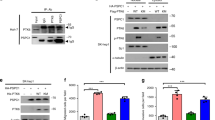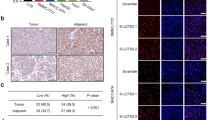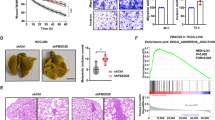Abstract
The PFTK1 gene encodes a cdc2-related serine/threonine protein kinase that has been shown to confer cell migratory properties in hepatocellular carcinoma (HCC). However, the prognostic value and biological mechanism by which PFTK1 promotes HCC motility remain largely unknown. Here, we showed from tissue microarray that common upregulations of PFTK1 in primary HCC tumors (n=133/180) correlated significantly with early age onset (⩽40 years), advance tumor grading and presence of microvascular invasion (P⩽0.05). To understand downstream phosphorylated substrate(s) of PFTK1, phospho-proteins in PFTK1 expressing and knockdown Hep3B cells were profiled by two-dimensional-polyacrylamide gel electrophoresis mass spectrometric analysis. Protein identification of differential spots revealed β-actin (ACTB) and transgelin2 (TAGLN2) as the two most profound phosphorylated changes affected by PFTK1. We verified the presence of TAGLN2 serine phosphorylation and ACTB tyrosine phosphorylation. Moreover, reduced TAGLN2 and ACTB phosphorylations in PFTK1-suppressed Hep3B corresponded to distinct actin depolymerizations and marked inhibition on cell invasion and motility. Given that TAGLN2 is a tumor suppressor whose function has been ascribed in cancer metastasis, we examined if TAGLN2 is an intermediate substrate in the biological path of PFTK1. We showed in PFTK1-suppressed cells that knockdown of TAGLN2 over-rode the inhibitory effect on cell invasion and motility, and a recovery on actin polymerization was evident. Interestingly, we also found that unphosphorylated TAGLN2 in PFTK1-suppressed cells elicited strong actin-binding ability, a mechanism that possibly halts the actin cytoskeleton dynamics. Site-directed mutagenesis of TAGLN2 suggested that PFTK1 regulates the actin-binding affinity of TAGLN2 through the S83 and S163 residues, which if mutated can significantly affect HCC cell motility. Taken together, our data propose a novel, oncogene-tumor suppressor interplay, where oncogenic PFTK1 confers HCC cell motility through inactivating the actin-binding motile suppressing function of TAGLN2 via phosphorylation.
This is a preview of subscription content, access via your institution
Access options
Subscribe to this journal
Receive 50 print issues and online access
$259.00 per year
only $5.18 per issue
Buy this article
- Purchase on Springer Link
- Instant access to full article PDF
Prices may be subject to local taxes which are calculated during checkout








Similar content being viewed by others
Abbreviations
- 2D-PAGE:
-
two-dimensional polyacrylamide gel electrophoresis
References
Assinder SJ, Stanton JA, Prasad PD . (2009). Transgelin: an actin-binding protein and tumour suppressor. Int J Biochem Cell Biol 41: 482–486.
Baek K, Liu X, Ferron F, Shu S, Korn ED, Dominguez R . (2008). Modulation of actin structure and function by phosphorylation of Tyr-53 and profilin binding. Proc Natl Acad Sci USA 105: 11748–11753.
Fu Y, Liu HW, Forsythe SM, Kogut P, McConville JF, Halayko AJ et al. (2000). Mutagenesis analysis of human SM22: characterization of actin binding. J Appl Physiol 89: 1985–1990.
García JL, Hernandez JM, Gutiérrez NC, Flores T, González D, Calasanz MJ et al. (2003). Abnormalities on 1q and 7q are associated with poor outcome in sporadic Burkitt's lymphoma. A cytogenetic and comparative genomic hybridization study. Leukemia 17: 2016–2024.
Herath NI, Leggett BA, MacDonald GA . (2006). Review of genetic and epigenetic alterations in hepatocarcinogenesis. J Gastroenterol Hepatol 21: 15–21.
Katoh H, Ojima H, Kokubu A, Saito S, Kondo T, Kosuge T et al. (2007). Genetically distinct and clinically relevant classification of hepatocellular carcinoma: putative therapeutic targets. Gastroenterology 133: 1475–1486.
Kirschner M . (1992). The cell cycle then and now. Trends Biochem Sci 17: 281–285.
Knuutila S, Bjorkqvist AM, Autio K, Tarkkanen M, Wolf M, Monni O et al. (1998). DNA copy number amplifications in human neoplasms: review of comparative genomic hybridization studies. Am J Pathol 152: 1107–1123.
Kubota H, Mikhailenko SV, Okabe H, Taguchi H, Ishiwata S . (2009). D-loop of actin differently regulates the motor function of myosins II and V. J Biol Chem 284: 35251–35258.
Manes T, Zheng DQ, Tognin S, Woodard AS, Marchisio PC, Languino LR . (2003). αvβ3 integrin expression up-regulates cdc2, which modulates cell migration. J Cell Biol 161: 817–826.
Nair RR, Solway J, Boyd DD . (2006). Expression cloning identifies transgelin (SM22) as a novel repressor of 92-kDa type IV collagenase (MMP-9) expression. J Biol Chem 281: 26424–26436.
Nakao K, Shibussawa M, Ishihara A, Yoshizawa H, Tsunoda A, Kusano M et al. (2001). Genetic changes in colorectal carcinoma tumors with liver metastases analyzed by comparative genomic hybridization and DNA ploidy. Cancer 91: 721–726.
Neumeister P, Pixley FJ, Xiong Y, Xie H, Wu K, Ashton A et al. (2003). Cyclin D1 governs adhesion and motility of macrophages. Mol Biol Cell 14: 2005–2015.
Pang E, Wong N, Lai PB, To KF, Lau WY, Johnson PJ . (2002). Consistent chromosome 10 rearrangements in four newly established human hepatocellular carcinoma cell lines. Genes Chromosomes Cancer 33: 150–159.
Pang EY, Bai AH, To KF, Sy SM, Wong NL, Lai PB et al. (2007). Identification of PFTAIRE protein kinase 1, a novel cell division cycle-2 related gene, in the motile phenotype of hepatocellular carcinoma cells. Hepatology 46: 436–445.
Pines J . (1992). Cell proliferation and control. Curr Opin Cell Biol 4: 144–148.
Poon RT, Fan ST, Lo CM, Liu CL, Wong J . (1999). Intrahepatic recurrence after curative resection of hepatocellular carcinoma: long-term results of treatment and prognostic factors. Ann Surg 229: 216–222.
Poon TC, Wong N, Lai PB, Rattray M, Johnson PJ, Sung JJ . (2006). A tumor progression model for hepatocellular carcinoma: bioinformatic analysis of genomic data. Gastroenterology 131: 1262–1270.
Rush J, Moritz A, Lee KA, Guo A, Goss VL, Spek EJ et al. (2005). Immunoaffinity profiling of tyrosine phosphorylation in cancer cells. Nat Biotechnol 23: 94–101.
Shields JM, Rogers-Graham K, Der CJ . (2002). Loss of transgelin in breast and colon tumors and in RIE-1 cells by Ras deregulation of gene expression through Raf-independent pathways. J Biol Chem 277: 9790–9799.
Solomon MJ . (1993). Activation of the various cyclin/cdc2 protein kinases. Curr Opin Cell Biol 5: 180–186.
Stewart BW, Kleihues P (eds). (2003). World Health Organization World Cancer Report. IARC Press: Lyon.
Strohmeyer DM, Berger AP, Moore II DH, Bartsch G, Klocker H, Carroll PR et al. (2004). Genetic aberrations in prostate carcinoma detected by comparative genomic hybridization and microsatellite analysis: association with progression and angiogenesis. Prostate 59: 43–58.
Vincent-Salomon A, Thiery JP . (2003). Host microenvironment in breast cancer development: epithelial–mesenchymal transition in breast cancer development. Breast Cancer Res 5: 101–106.
Wong N, Yeo W, Wong WL, Wong NL, Chan KY, Mo FK et al. (2009). TOP2A overexpression in hepatocellular carcinoma correlates with early age onset, shorter patients survival and chemoresistance. Int J Cancer 124: 644–652.
Wulfkuhle JD, Sgroi DC, Krutzsch H, McLean K, McGarvey K, Knowlton M et al. (2002). Proteomics of human breast ductal carcinoma in situ. Cancer Res 62: 6740–6749.
Xu SG, Yan PJ, Shao ZM . (2010). Differential proteomic analysis of a highly metastatic variant of human breast cancer cells using two-dimensional differential gel electrophoresis. J Cancer Res Clin Oncol 136: 1545–1556.
Yang T, Chen JY . (2001). Identification and cellular localization of PFTAIRE1. Gene 267: 165–172.
Yang Z, Chang YJ, Miyamoto H, Ni J, Niu Y, Chen Z et al. (2007). Transgelin functions as a suppressor via inhibition of ARA54-enhanced androgen receptor transactivation and prostate cancer cell growth. Mol Endocrinol 21: 343–358.
Zhao L, Wang H, Deng YJ, Wang S, Liu C, Jin H et al. (2009). Transgelin as a suppressor is associated with poor prognosis in colorectal carcinoma patients. Mod Pathol 22: 786–796.
Acknowledgements
This work was supported by a Collaborative Research Fund from the Hong Kong Research Grants Council (Ref. No.: CUHK 4/CRF/08) and an Earmarked Grant from the Hong Kong Research Grants Council (Ref. No.: CUHK 4410/06M). We thank AH Bai and NL Wong for technical assistance.
Author information
Authors and Affiliations
Corresponding author
Ethics declarations
Competing interests
The authors declare no conflict of interest.
Additional information
Supplementary Information accompanies the paper on the Oncogene website
Rights and permissions
About this article
Cite this article
Leung, W., Ching, A., Chan, A. et al. A novel interplay between oncogenic PFTK1 protein kinase and tumor suppressor TAGLN2 in the control of liver cancer cell motility. Oncogene 30, 4464–4475 (2011). https://doi.org/10.1038/onc.2011.161
Received:
Revised:
Accepted:
Published:
Issue Date:
DOI: https://doi.org/10.1038/onc.2011.161
Keywords
This article is cited by
-
Cyclins and cyclin-dependent kinases: from biology to tumorigenesis and therapeutic opportunities
Journal of Cancer Research and Clinical Oncology (2023)
-
MiR-613 inhibits the proliferation, migration, and invasion of papillary thyroid carcinoma cells by directly targeting TAGLN2
Cancer Cell International (2021)
-
Identification of targets of JS-K against HBV-positive human hepatocellular carcinoma HepG2.2.15 cells with iTRAQ proteomics
Scientific Reports (2021)
-
Ketamine-induced urological toxicity: potential mechanisms and translation for adults with mood disorders receiving ketamine treatment
Psychopharmacology (2021)
-
An Essential Role for TAGLN2 in Phagocytosis of Lipopolysaccharide-activated Macrophages
Scientific Reports (2017)



